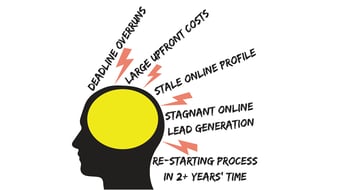We think you’ll agree that writing meta descriptions for every single page on your site is a daunting task. Especially if your site racks up hundreds or even thousands of pages.
So what are your options? Copy + Paste meta descriptions for similar pages? Allocate the time needed to research and implement unique, high-quality descriptions? Outsource to an agency?
Regardless of the how, it's crucial you avoid the common pitfall of duplicate meta descriptions. While it won't necessarily break your website, it will impact it in a less than positive way.
Read on to get a better idea of what a duplicate meta description is, why you should avoid them, and how to construct unique and compelling descriptions to optimise your site for search engines.
If you use tools like Sitebulb or Screaming Frog as part of your content strategy, you may have been slapped with the ominous “duplicate meta description” warning.
What does it mean? And what can you do about it to improve SEO?
We'll show you how to craft meta descriptions that tick all of Google’s mysterious boxes.
What Are Duplicate Meta Descriptions?
If more than two meta descriptions on your site are identical, or at least similar, they are considered a duplicate.
This is most common on websites that have a range of similar products or services, and have perhaps had a "template" applied across their meta descriptions.
Duplicates are problematic in terms of helping search engines understand the context of your page; how should Google prioritise displaying one page when you have the same core description across multiple other pages? They're also problematic for other reasons (brevity, non-descriptive) but that’s for another day, and another blog post.
You might think that changing up a keyword across multiple similar descriptions is the loophole everyone's been looking for, but that's not the case.
Some examples of duplicate meta descriptions. Despite having minor differences between departments and keywords, they are carbon copies. This can be misleading to both humans and search engines.
Why Does Your Website Need Meta Descriptions?
To understand why duplicate meta descriptions are problematic, let’s take a step back and understand why we need meta descriptions in the first place.
Meta descriptions exist to give users an idea of what to expect on a web page, compelling them to click through if it reiterates a solution to their problem. Meta descriptions are also useful for search engines as signposts indicating the purpose of a web page.
In the old days of SEO, metadata was a more prominent ranking factor. What we mean by that is there were far fewer avenues to achieve top rankings than there are today. This placed a lot of pressure on webmasters or consultants delivering SEO services to craft meta descriptions with as many keywords as possible. And keyword stuffing was born!
This led to a crackdown by Google. Webmasters began being penalised for keyword-stuffed descriptions, duplicate descriptions, and even missing descriptions.
Nowadays, there are numerous factors that determine a pages ability to rank and while meta descriptions are still relatively high on that list, there's a lot more scope to support growing rankings than before.
For clarity: meta descriptions need to meet certain criteria outlined in best practice guidelines. They DO influence rankings, but to less of an extent than before.
Are Unique Meta Descriptions Important?
Yes. And no.
Google may decide to ignore your meta descriptions.
Over the years, we've learned that Google has the final say in how your content performs, and how it is displayed. You may have spent hours crafting the most compelling, natural-sounding meta description - only to have Google display a snippet extracted from the body of your content in place of that meta description.
A quick example: If I search ‘property news Guardian’, this comes up:

The meta description matches the example we outlined earlier in this blog. Google has decided that the site’s meta description is an accurate description of the contents of the page, and has pulled it through to the SERP (search engine results page).
If I search ‘the Cadbury story’, something interesting happens...

Here, Google has disregarded the meta description filled in by the webmaster. Instead, the search engine has pulled through copy from the page which it feels provides a better description and a better answer to the search query.
It is important to note that knowing that Google will do the work for you is not an excuse to get complacent with meta descriptions.
In summary: do the work, put in the effort, and DO create unique meta descriptions. But don't be surprised or annoyed if they don't display on SERPs.
Should You Still Write Unique Meta Data?
See our closing thought above, but to reiterate: Our answer to this would still be a resounding yes.
"But, why?" - we hear you ask.
Imagine you have two stacks of magazines: one has a variety of interesting titles, the other has 50 copies of today's newspaper. Which one are you more likely to browse?
This logic applies to web pages, too. If you have too many duplicate issues, search engines may register or flag some of your content as spam, low-quality, or repeated content. This results in a drop in rankings, domain authority, visibility, share of voice, etc. You have a lot to lose in exchange for 160 meagre characters.
Consider meta descriptions your site’s first impression. Not impression in terms of metrics, but perhaps their elevator pitch.
- For search engines, they provide a top-level clue about your site’s content.
- For users, they provide a brief description of the contents of each page, which will help users decide whether or not to click through to the said page.
Consider meta descriptions primarily as a click-through rate enhancement tool, and secondarily as an SEO tool.
How To Write Meta Descriptions In 2021: Tips. & FAQs
With all this in mind, here are our top tips for fit-for-purpose meta descriptions, and some answers to frequently asked questions around meta descriptions.
Human-First Descriptions
Write your description with human users in mind. Do not, I repeat, do not stuff keywords in, or create unnatural-sounding descriptions just for the sake of hoping to display for some additional terms. Imagine you're describing the page to a friend, and want to convince them to take a closer look.
Meta Descriptions Are Your Elevator Pitch
We mentioned this earlier, but it's worth expanding on. Meta descriptions are the longest body of text a user will see when your page is displayed on SERPs. The best structure for your description comprises two major elements: describe, compel. Explain to the user what the page is about, and encourage them to click through.
For example: "What are duplicate meta descriptions & how can you fix them? Our blog on this topic covers all the bases to help you boost your SEO using meta data."
Write Meta Descriptions For Each Page And Blog Post As They Are Published
This is when the content is most fresh in your mind, and it makes the task infinitely less tedious. Additionally, supplying Google with this info from the outset makes it far easier for them to add content and index your page using the meta data you've supplied, instead of them needing to scrape your content for relevant copy to use.
How Long Should A Meta Description Be?
The general guideline for character counts on meta descriptions is 155 - 160 characters. This doesn't account for spacing, though. The best way to ensure your meta description isn't truncated is to run it through a meta description checker tool, like TechnicalSEO.com by Merkle. This will show you exactly how your meta description is displayed on SERPs across desktop AND mobile! Simply navigate to SEO Tools, then to SERP Simulator.
Google Showing Old Meta Description? Here's What You Can Do.
We previously mentioned that Google has the final say in what it displays as your meta description. If you've created a new meta description and added it to your page, it's likely for a very good reason. Google may still choose to display your old description, and while you can do some things to support your new description in being displayed, it's worth reiterating that Google always has the final say.
To help get your new description displayed:
- Submit your updated URL on Search Console under the "URL Inspection" tab.
- Add schema markup to your page which highlights the meta description.
- Alternatively, you can amend the part of the copy in the body of your article which Google is displaying. Bear in mind this could rattle your rankings, so ensure you do this correctly and monitor any volatility or changes,
How To Remove Duplicate Meta Descriptions
If you've had some duplicate meta descriptions flagged, here are the two most practical ways to rectify them.
- Remove: If one of the pages is no longer in use, delete or redirect it. No point wasting time working on meta data for a page you don't want!
- Update: If both (or more) pages are still relevant, spend some time creating a unique description for each. You can convey the same message ina. different way, and that's all that's needed.
While duplicate meta descriptions may seem less of a priority against other SEO techniques and strategies, they're still very important. It doesn't need to take up a disproportionate amount of your time, but this is definitely a case of "a little goes a long way".
Why not claim a free SEO audit to identify any issues that might be affecting the performance of your site?





